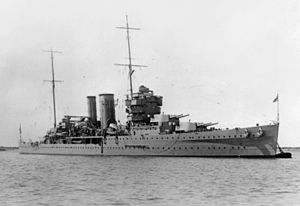
Back Тежки крайцери тип „Йорк“ Bulgarian Třída York Czech York-Klasse German Clase York Spanish ناو کلاس یورک Persian York-luokka (risteilijä) Finnish Classe York French ヨーク級重巡洋艦 Japanese Classe York Portuguese Тяжёлые крейсера типа «Йорк» Russian

| |
| Class overview | |
|---|---|
| Name | York class |
| Operators | |
| Preceded by | County class |
| Succeeded by | None |
| Built | 1927-1931 |
| In commission | 1930-1942 |
| Planned | 7 |
| Completed | 2 |
| Cancelled | 5 |
| Lost | 2 |
| General characteristics - York | |
| Type | Heavy cruiser |
| Displacement | 8,250 tons standard / 10,350 tons full load |
| Length | |
| Beam | 57 ft (17.4 m) |
| Draught | 17 ft (5.2 m) |
| Propulsion |
|
| Speed | 32.25 knots (59.73 km/h) (30.25 knots (56.02 km/h) full load) |
| Range | 1,900 tons oil fuel; 10,000 nmi (20,000 km) at 14 knots (26 km/h) |
| Complement | 623 |
| Armament |
|
| Armour | |
| Aircraft carried | One × Fairey Seafox |
| Aviation facilities | rotating catapult |
| General characteristics - Exeter | |
| Displacement | 8,390 tons standard / 10,410 tons full load |
| Beam | 58 ft (17.7 m) |
| Complement | 630 |
| Armour |
|
| Aircraft carried | Two x Fairey Seafox, later Supermarine Walrus |
| Aviation facilities | Two fixed catapults |
| Notes | Other characteristics as per York |
The York class was the second and final class of heavy cruisers built for the Royal Navy under the terms of the 1922 Washington Naval Treaty. They were essentially a reduced version of the preceding County class, scaled down to enable more cruisers to be built from the limited defence budgets of the late 1920s.
It was initially planned to build seven ships of this class, though in the end only two were constructed—HMS York, started in 1927, and HMS Exeter, started in 1928. Exeter differed in appearance from York because of late changes in her design. The remaining ships were delayed due to budget cuts, and then following the London Naval Treaty of 1930 the Royal Navy decided its cruiser needs were best met by building a greater number of yet smaller cruisers with 6–in guns.[1]
While both ships served extensively in the first few years of the Second World War, it was Exeter that had the more notable career. Exeter took part in the Battle of the River Plate against the German raider Admiral Graf Spee, and was badly damaged, though later she was repaired and modernized. She escorted a convoy to the Pacific in late 1941, and was again heavily damaged in the Battle of the Java Sea, then caught and overwhelmed a few days later by four Japanese heavy cruisers. York was sunk in Suda Bay, Crete, by Italian MT boats in 1941, and was raised in 1952 and towed away to be scrapped in Italy.
- ^ Marriott, p. 35